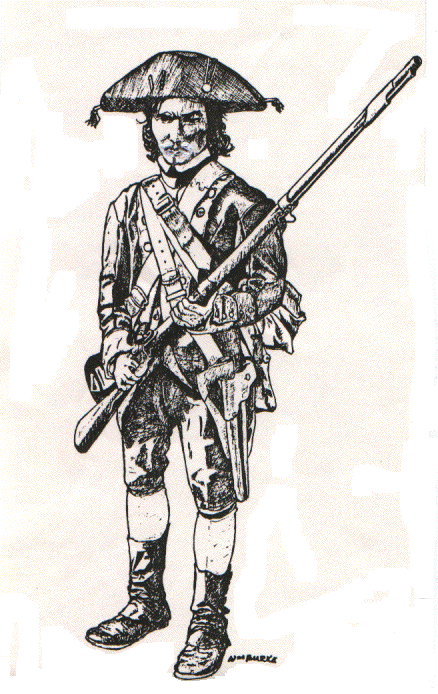

The 10th Virginia Regiment
10th Virginia Regiment Arms and Accouterments
I. How items were issued:
A. There is often the expectation that arms and accouterments will be uniform for any given time period. Archival records show that the Quartermaster Department issued items piecemeal from stores as they were lost or worn out. Damaged items were returned to the armories to be repaired and were then reissued leading to a certain amount of variability within each unit.
B. When the Regiment was inspected in May of 1779, arms and accouterments were described as being "recently completed and in good order". Each soldier's uniform impression should include the following:
II. Musket:
A. Almost any European pattern military musket (1720-1777) could have found its way into Continental service. The following modern reproductions are appropriate.
1. 1763 or 1768 model Charleville, most commonly issued arm in 1778-9
2. British Long or Short Land pattern (Brown Bess), Committee of Safety
Musket are most common during the early war.
3. 1777 model French Charleville acceptable as a late war alternative.
B. Mandatory features:
1. Bayonet, appropriate to the type of musket, and must have a proper fit
a. heavy leather scabbard, dyed black
b. brass tip to above to prevent push through
2. Sling, made of harness leather or hemp webbing. Patterns include:
a. the two piece type that buckles together.
b. the one piece type that hooks
3. For Safety
a. Brass flash guard, BAR pattern is preferred.
b. Hammerstall
c. Bayonet lug
4. The musket should have a sound stock and be in good working order.
C. Rifles, fusils, and carbines are not appropriate for a line soldier impression
III. Cartridge Box
A. Mid War rectangular, similar in shape and size to the M1808 federal box
1. 26 round block, with inner protective cover nailed on
2. Wooden tool tray, outer leather tool pocket
3. brass closure finial, iron sling buckles (2)
4. hemp and leather sling
5. Whisk and pick
6. Cleaning kit composed of oil vial, gun work, screwdriver, rouge polish, tow and linen patches.
B. Tin Canister, japanned black, with canvas or hemp sling, is an acceptable substitute.
IV. Bayonet Carriage
A. Harness leather single frog, dyed black
B. hemp web sling
V. Canteen
1. Wooden cylinder type with leather sling
2. tin kidney type with hemp or linen rope sling
VI. Camp and Mess Gear
A. Haversack, brown linen or hemp
B. Knapsack, 1776 pattern, waterproofed with venetian red paint
C. Blanket: should be wool, colors include natural, gray, brown or dun, often with a black stripe.
D. Mess Kit
1. tin cup
2. mess tin, or wooden bowl or trencher
3. wooden or pewter spoon, optional twisted wire fork
4. folding pocket knife
E. other issued items include
1. housewife with needle, thread, and patches
2. razor, horn comb, and lye soap
3. black ball (shoe polish) tin and shoe brush